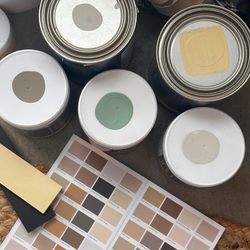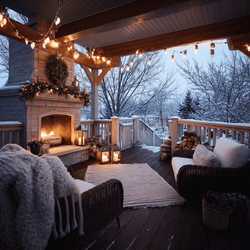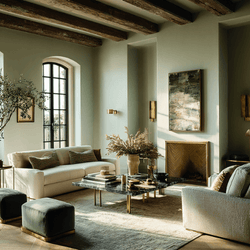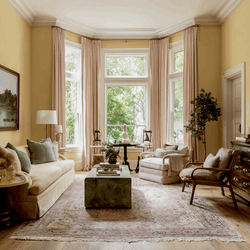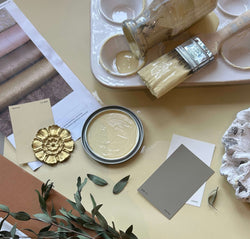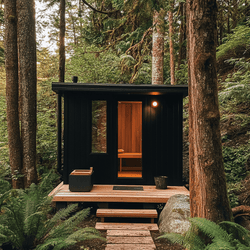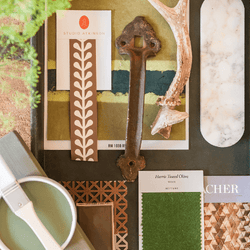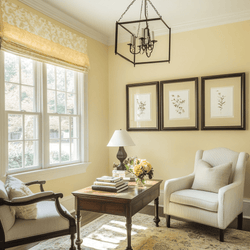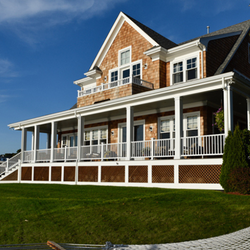How Mood and Color Influence Design

How moody are you? What is your color story? One might ask these questions when approaching an interior design project. The presence, or absence of color is in our daily lives — from the moment the sun rises, casting its tone and mood on the day, to the clothes we wear, to the spaces we live in. Light and color are synonymous. Looking inward to the space we live in, specific hues can provoke different emotions, associations, and responses that affect how one’s home is perceived. In fact, some research has shown that color can increase mood up to 80%.
Let Color Choices Dictate Design Plans. Color choices can make or break a design. Fortunately, we are far from the times when our color choices were limited to a small batch of natural pigments. Synthetic pigments and the screen have made our lives increasingly easier, while also making decisions infinitely more complex.

Full spectrum paint creates a dynamic, luminous effect
Faced with such an overwhelming amount of color options in today’s markets, many homeowners profess to be afraid of color, for fear of making mistakes. Consulting with an interior designer when selecting a color palette for a design project is an integral part of the process.
How Mood and Color Create Your Story. When telling a client’s color story, I always start with getting to know their personality and lifestyle. A color story should reflect various elements of a personality to avoid looking like a theme, so it has always been important to me to add a mixture of light and dark.

Each room tells a story
A rich color story should also be offer flexibility and adaptation – I decorate for all seasons and moods. Purely as a personal preference, the complexity of moods is what I am drawn to, love and relate to. I probably wouldn’t be happy in a totally light, airy home; my nature and personality requires a moody house so much so that a light and cheery environment, for me, would feel as if it was missing some depth, richness and contrast.

Darker colors create a sense of richness and depth
While I typically have a mix of light and dark all in one room, I also find it creatively interesting to experience various moods as I wander through the house. The “moodiness” of a room doesn’t have to come only from colored or dark walls, of course, it can also be achieved through layers, darker floors, a mix of richer furniture, antiques, fabrics, or painted cabinets—all combined to reflect a mood and tell a story.
A color story should reflect various elements of a personality to avoid looking like a theme.
At times, the actual space also dictates the setting of a mood. Moody rooms might feel more appropriate with certain styles or even locations and settings of a house. Case in point, when a space has a lot of natural light at the back of a house, dark wall colors would feel washed out, so a lighter color and tone and mood works best in those rooms.

Play off the natural light
For me, I feel best when the mood of a home feels inspired by and incorporates aspects of the mood of the natural habitat we live in. I tend to feel more comfortable with colors that have slightly warmer or gray undertones. Selecting colors that reflect and arouse a sense of cohesiveness inside and out feels more settling and comforting to me. So, don’t be afraid of being moody. Use it to tell your personal color story.
About Designer, David Chenault

David Anthony Chenault
These words have been used by clients and peers to describe the designer who is David Anthony Chenault. Born in Denver, Colorado and raised in Missouri, David Anthony Chenault had a creative eye and a penchant for making things beautiful since early childhood. He was simply born and destined to be a designer. He went on to graduate with a degree in Architecture with an emphasis in Interior Design from Southwest Missouri State University.
Over the course of 28 years, David has since transformed many homes in the tri-state area, as well as designed memorable residential and commercial projects across the country. As the principal interior designer for David Anthony Chenault Interior Design, David creates fresh, timeless spaces that are beautiful, elegant, and unforgettable. The design is a collaboration of his own vision and that of identifying the dream that is within the client’s desires. The style of his work is traditional with a modern approach. “We want our homes to reflect the client’s lifestyle, not a fancy trend,” he says. “Homes should emanate personality and warmth, and be comfortable and livable while retaining a certain formality.” David’s work has been published in Christie’s Great Estates, Home & Design, Washingtonian, Northern Virginia, Architectural Digest and 417. Regularly featured in Houzz.com, currently, Home and Design “PORTFOLIO” has also added David as one of the Tri states’ Top 100 Designers.
Contact David at www.davidanthonychenault.com


